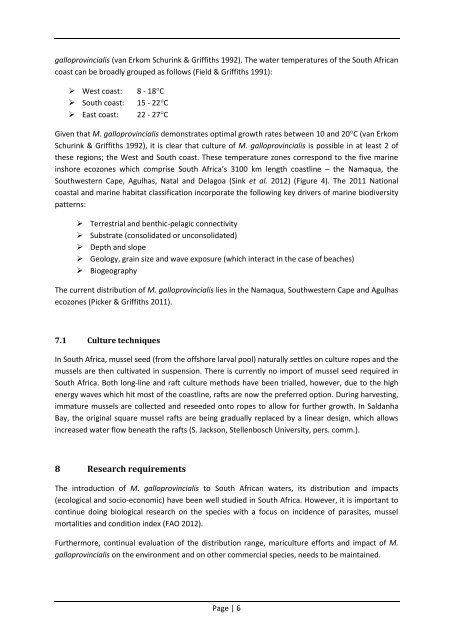Mediterranean mussel Mytilus galloprovincialis - Department of ...
Mediterranean mussel Mytilus galloprovincialis - Department of ...
Mediterranean mussel Mytilus galloprovincialis - Department of ...
Create successful ePaper yourself
Turn your PDF publications into a flip-book with our unique Google optimized e-Paper software.
<strong>galloprovincialis</strong> (van Erkom Schurink & Griffiths 1992). The water temperatures <strong>of</strong> the South Africancoast can be broadly grouped as follows (Field & Griffiths 1991):‣ West coast: 8 - 18°C‣ South coast: 15 - 22°C‣ East coast: 22 - 27°CGiven that M. <strong>galloprovincialis</strong> demonstrates optimal growth rates between 10 and 20°C (van ErkomSchurink & Griffiths 1992), it is clear that culture <strong>of</strong> M. <strong>galloprovincialis</strong> is possible in at least 2 <strong>of</strong>these regions; the West and South coast. These temperature zones correspond to the five marineinshore ecozones which comprise South Africa’s 3100 km length coastline – the Namaqua, theSouthwestern Cape, Agulhas, Natal and Delagoa (Sink et al. 2012) (Figure 4). The 2011 Nationalcoastal and marine habitat classification incorporate the following key drivers <strong>of</strong> marine biodiversitypatterns:‣ Terrestrial and benthic-pelagic connectivity‣ Substrate (consolidated or unconsolidated)‣ Depth and slope‣ Geology, grain size and wave exposure (which interact in the case <strong>of</strong> beaches)‣ BiogeographyThe current distribution <strong>of</strong> M. <strong>galloprovincialis</strong> lies in the Namaqua, Southwestern Cape and Agulhasecozones (Picker & Griffiths 2011).7.1 Culture techniquesIn South Africa, <strong>mussel</strong> seed (from the <strong>of</strong>fshore larval pool) naturally settles on culture ropes and the<strong>mussel</strong>s are then cultivated in suspension. There is currently no import <strong>of</strong> <strong>mussel</strong> seed required inSouth Africa. Both long-line and raft culture methods have been trialled, however, due to the highenergy waves which hit most <strong>of</strong> the coastline, rafts are now the preferred option. During harvesting,immature <strong>mussel</strong>s are collected and reseeded onto ropes to allow for further growth. In SaldanhaBay, the original square <strong>mussel</strong> rafts are being gradually replaced by a linear design, which allowsincreased water flow beneath the rafts (S. Jackson, Stellenbosch University, pers. comm.).8 Research requirementsThe introduction <strong>of</strong> M. <strong>galloprovincialis</strong> to South African waters, its distribution and impacts(ecological and socio-economic) have been well studied in South Africa. However, it is important tocontinue doing biological research on the species with a focus on incidence <strong>of</strong> parasites, <strong>mussel</strong>mortalities and condition index (FAO 2012).Furthermore, continual evaluation <strong>of</strong> the distribution range, mariculture efforts and impact <strong>of</strong> M.<strong>galloprovincialis</strong> on the environment and on other commercial species, needs to be maintained.Page | 6
















